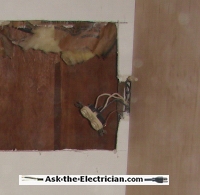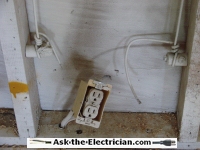» Home
» Electrical Wiring Directory
» Home Electrical Inspections
» Need Electrical Help? Ask the Electrician
» Need Electrical Help? Ask the Electrician
Basic Electrical Wiring Methods Explained

|
By Dave Rongey
Summary: Helping you with your Home Electrical Wirig Projects. © By: Dave Rongey |
Test Your Electrical Know-How, Gain Electrical Code Knowledge
Identify Electrical Problems
I really admire people who decide to do electrical wiring projects around the home, but Please don't do work like this!
Shown Below:
This was an interesting discovery. An existing ceiling fan which was installed without an electrical box.
The wire had been poked down through the ceiling sheet rock.
Without the approved box enclosure there is no legal ground and no way to contain an electrical incident if there ever was one. Also, there was no way to use the appropriate mounting screws for an approved 70 lb rated Ceiling Fan box. Instead, long sheet rock style screws were used. I have found similar occurrences with ceiling fixtures in older homes, however it was quite a surprise to find this violation and several more in a home which had recently been "remodeled", complete with a total kitchen makeover - all installed by an alleged "licensed general contractor", and it all had to be rewired!
The following pictures have some wiring hazards violations and possible hazards. Can you pin point the problems? Go through the pictures and see how you do.
 |
 |
 |
| This plug box was half buried when the cabinet on the right was installed. With no way to access, install or cover the receptacle the wiring had to be removed and relocated. | I noticed this at a public area. Broken weather proof covers and no sign of GFCI protection. Hopefully there was a GFCI Breaker providing protection | Upgrading old Knob and Tube wiring is great, just don't forget to either remove the old wire or terminate it in a junction box. |
 |
 |
 |
| Oops - looks like a noninsulated wire that was run inside the wall to a outside fixture. Make sure the integrity of the sheath is maintained. | Two problems: 14/2 mixed with 12/2 and unbonded ground to the metal box. Never mix wire gages and always bond the ground wire together and to the metal box with a Ground Screw. | Another Ground issue. The cable clamp in this box is not approved for bonding the ground and it is not necessary because the box is not metal. Always join the grounds. |
 |
 |
 |
| This panel needed some attention especially because there were several ground wire that were cut off and not terminated to the ground bar. | Illegal grounding method using the cover screw instead of using a ground screw in the pre-tapped hole. | This is what happens when a back hoe pulls up the well pump conduit. Also notice the water PVC entering this control box which supplies the power. It is not entering through a provided knock-out. |
 |
||
| This was really bad. Here we have two circuits of 12/2 ungrounded cables feeding a 220 volt 30 amp dryer receptacle AND a 120 volt circuit that is tapped on with the red wire to the dryer. |
|
||||||||
The Safest Way to Test Electrical Devices and Identify Electric Wires!The Non-Contact Electrical TesterThis is a testing tool that I have had in my personal electrical tool pouch for years, and is the first test tool I grab to help identify electrical wiring. It is a Non-contact tester that I use to easily Detect Voltage in Cables, Cords, Circuit Breakers, Lighting Fixtures, Switches, Outlets and Wires. Simply insert the end of the tester into an outlet, lamp socket, or hold the end of the tester against the wire you wish to test. Very handy and easy to use.
The Quickest Way to Check for Faulty Electrical Wiring!The Plug-In Outlet TesterThis is the first tool I grab to troubleshoot a problem with outlet circuit wiring. This popular tester is also used by most inspectors to test for power and check the polarity of circuit wiring. It detects probable improper wiring conditions in standard 110-125 VAC outlets Provides 6 probable wiring conditions that are quick and easy to read for ultimate efficiency Lights indicate if wiring is correct and indicator light chart is included Tests standard 3-wire outlets UL Listed Light indicates if wiring is incorrect Very handy and easy to use.
Strip Off Wire Insulation without Nicking and Damaging the Electric Wire!The Wire Stripper and Wire CutterMy absolute favorite wire stripping tool that I have had in my personal electrical tool pouch for years, and this is the tool I use to safely strip electrical wires. This handy tool has multiple uses: The wire gauges are shown on the side of the tool so you know which slot to use for stripping insulation. The end of the tool can be used to grip and bend wire which is handy for attaching wire onto the screw terminals of switches and outlets.. The wire stripper will work on both solid and stranded wire. This tool is Very Handy and Easy to Use. |
||
Residential Electrical Parts and AccessoriesLight Switches 120volt Outlets Circuit Breakers Electrician Tools Voltage Testers |
| Questions and Answers about Electrical Inspection |
The Safest Way to Test Electrical Devices and Identify Electric Wires!The Non-Contact Electrical TesterThis is a testing tool that I have had in my personal electrical tool pouch for years, and is the first test tool I grab to help identify electrical wiring. It is a Non-contact tester that I use to easily Detect Voltage in Cables, Cords, Circuit Breakers, Lighting Fixtures, Switches, Outlets and Wires. Simply insert the end of the tester into an outlet, lamp socket, or hold the end of the tester against the wire you wish to test. Very handy and easy to use.
The Quickest Way to Check for Faulty Electrical Wiring!The Plug-In Outlet TesterThis is the first tool I grab to troubleshoot a problem with outlet circuit wiring. This popular tester is also used by most inspectors to test for power and check the polarity of circuit wiring. It detects probable improper wiring conditions in standard 110-125 VAC outlets Provides 6 probable wiring conditions that are quick and easy to read for ultimate efficiency Lights indicate if wiring is correct and indicator light chart is included Tests standard 3-wire outlets UL Listed Light indicates if wiring is incorrect Very handy and easy to use.
Strip Off Wire Insulation without Nicking and Damaging the Electric Wire!The Wire Stripper and Wire CutterMy absolute favorite wire stripping tool that I have had in my personal electrical tool pouch for years, and this is the tool I use to safely strip electrical wires. This handy tool has multiple uses: The wire gauges are shown on the side of the tool so you know which slot to use for stripping insulation. The end of the tool can be used to grip and bend wire which is handy for attaching wire onto the screw terminals of switches and outlets.. The wire stripper will work on both solid and stranded wire. This tool is Very Handy and Easy to Use. |
||
Residential Electrical Parts and AccessoriesLight Switches 120volt Outlets Circuit Breakers Electrician Tools Voltage Testers |















